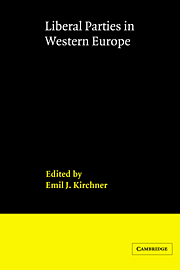Book contents
- Frontmatter
- Contents
- List of tables
- List of diagrams
- List of maps
- Notes on the contributors
- Preface
- 1 Introduction
- 2 Between left and right: the ambivalence of European liberalism
- 3 Two roads of Italian liberalism: the Partito Repubblicano Italiano (PRI) and the Partito Liberale Italiano (PLI)
- 4 The FDP in the Federal Republic of Germany: the requirements of survival and success
- 5 Great Britain — social liberalism reborn?
- 6 Liberalism in France
- 7 Liberal parties in the Netherlands
- 8 The Belgian liberal parties: economic radicals and social conservatives
- 9 The Freiheitliche Partei Österreichs: protest party or governing party?
- 10 The Swedish Liberal Party: The politics of unholy alliances
- 11 Liberalism in Denmark: agrarian, radical and still influential
- 12 The Norwegian Liberal Party: from political pioneer to political footnote
- 13 Liberal parties in Finland: from perennial coalition actors to an extra-parliamentary role
- 14 Liberal parties in Switzerland
- 15 The Luxemburg Liberal Party
- 16 Identifying liberal parties
- 17 Ambivalence revisited: an analysis of liberal party manifestos since 1945
- 18 Transnational links: the ELD and Liberal Party Group in the European Parliament
- 19 Western European liberal parties: developments since 1945 and prospects for the future
- Index of political parties
- General index
12 - The Norwegian Liberal Party: from political pioneer to political footnote
Published online by Cambridge University Press: 16 November 2009
- Frontmatter
- Contents
- List of tables
- List of diagrams
- List of maps
- Notes on the contributors
- Preface
- 1 Introduction
- 2 Between left and right: the ambivalence of European liberalism
- 3 Two roads of Italian liberalism: the Partito Repubblicano Italiano (PRI) and the Partito Liberale Italiano (PLI)
- 4 The FDP in the Federal Republic of Germany: the requirements of survival and success
- 5 Great Britain — social liberalism reborn?
- 6 Liberalism in France
- 7 Liberal parties in the Netherlands
- 8 The Belgian liberal parties: economic radicals and social conservatives
- 9 The Freiheitliche Partei Österreichs: protest party or governing party?
- 10 The Swedish Liberal Party: The politics of unholy alliances
- 11 Liberalism in Denmark: agrarian, radical and still influential
- 12 The Norwegian Liberal Party: from political pioneer to political footnote
- 13 Liberal parties in Finland: from perennial coalition actors to an extra-parliamentary role
- 14 Liberal parties in Switzerland
- 15 The Luxemburg Liberal Party
- 16 Identifying liberal parties
- 17 Ambivalence revisited: an analysis of liberal party manifestos since 1945
- 18 Transnational links: the ELD and Liberal Party Group in the European Parliament
- 19 Western European liberal parties: developments since 1945 and prospects for the future
- Index of political parties
- General index
Summary
historical development
The Liberal Party occupies a central position in Norwegian political history and its origin is intimately linked to crucial events in the development of the Norwegian state from the late nineteenth century onwards. As Diagram 12.1 shows, the Liberal Party was not only one of the first two parties to be formed in the Norwegian political system, but it is also directly linked to the development of several other parties.
However, as we shall see, the history of the Liberal Party is also one of more or less continuous decline: its greatest electoral success was in 1885 when it won 76 of the 123 seats in the Storting (parliament). One hundred years later it was without any parliamentary representation at all. The large number of splits in the party suggests an extreme heterogeneity in its origin, a heterogeneity that could not be continued once the reason for the party's establishment had become unimportant.
Origin
The formation of the Norwegian Liberal Association on 29 August 1884 was one step in the development of the most serious political crisis in Norway after the country had entered a union with Sweden in 1814. At issue was the question of whether the king had the right to veto a constitutional amendment which the parliament had voted in favour of three times. This issue was later referred to as the struggle over parliamentarianism. The first two Norwegian parties, the Liberals and their opponents – the Conservatives – emerged over this issue, with the Liberals as the reformers.
- Type
- Chapter
- Information
- Liberal Parties in Western Europe , pp. 304 - 325Publisher: Cambridge University PressPrint publication year: 1988



